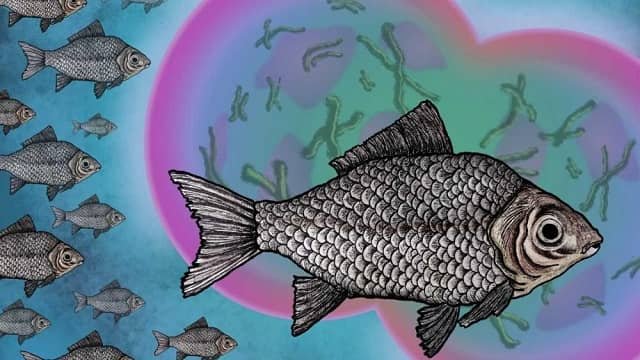by Forschungsverbund Berlin e.V. (FVB)
Hydroelectric turbines put fish at risk of severe injury during passage. To support an informed debate on the sustainability of hydropower, reliable data of turbine-induced fish mortality are pivotal. A team of researchers of the Leibniz Institute of Freshwater Ecology and Inland Fisheries (IGB) has now provided a first global analysis in the journal Conservation Biology. On average, 22.3 percent of all fish passing through turbines got killed or showed severe, potentially lethal injuries.
Worldwide, the number of hydropower plants is rapidly increasing. In Europe, 21,000 hydropower plants are in operation, and 8,500 more are planned. However, there is a lack of knowledge about their impact on riverine fish stocks. To provide reliable estimates of turbine-related fish mortality across fish species and turbine types, the researchers have compiled and analysed a global dataset of more than 275,000 individual fish from 75 species.
Mortality data were retrieved from field-based assessments at 122 hydropower sites of varying sizes in 15 countries worldwide. Analysed turbine types included Kaplan, Francis, and Very-Lowhead (VLH) turbines, as well as Archimedean screws and water wheels. “Turbine-related fish mortality has generally been studied before, but mostly at single sites. Our study now provides a large, global-scale analysis, considering a wide range of fish species and turbine types. This makes such a dataset and its evaluation so unique and meaningful,” explained IGB researcher Dr Johannes Radinger, the study’s lead author.
Risk depends on fish length, species and the turbines installed
Turbine-related mortality is especially critical for migratory fish species, such as salmon, sturgeons or eels, for which entire cohorts of juveniles or spawners need to migrate downstream to the sea to fulfill their life cycle thereby potentially passing turbines. But also, populations of so-called potamodromous fish (e.g. barbel, nase), i.e. species that migrate over long distances within the river systems might be affected. Here, it is particularly the cumulative effect of several hydropower plants that impacts migrating populations.
“While analysing this global dataset, we paid particular attention to adequately account for uncertainties related to empirical estimates such as fish handling and methodological differences in fish sampling to ensure highest reliability and robustness of the determined mortality rates,” said Radinger. The result: on average across all studies, one in five fish (22.3 percent) suffers fatal injuries when passing through a hydropower turbine.
How likely a fish gets injured or killed during turbine passage depends on its size, species, life stage, and other biological characteristics, among other factors. Generally, the odds for lethal effects increase with fish length, but also depend on the turbine type installed. Slower rotating turbines such as VLH turbines and water wheels are less harmful to fish compared with most conventional turbine types. However, the analysis also revealed a large variability in mortality rates for conventional turbine types, which is particularly interesting. There are in fact hydropower plants with turbine configurations that successfully reduce mortality rates.
Standards needed: fish-protective turbines and functioning fish migration facilities
Fish-protective turbines with appropriate technical and operational configurations accompanied with functioning up- and downstream fish-migration facilities that successfully prevent fish from entering the turbines must become the gold standard. However, such plants are still very rare. The development of fish-protective turbines or an adjustment of common turbines should therefore be evaluated using standardised, controlled methods under realistic field conditions, the researchers recommended.
Stay Always Informed
Join our communities to instantly receive the most important news, reports, and analysis from the aquaculture industry.
They also emphasised the relevance beyond Germany and Europe: Given the ongoing hydropower boom in particularly species-rich, large river systems, the need for globally adopting such a standard has never been higher. This is the only way to balance the needs for renewable energy with those of biodiversity protection and environmental enhancement of riverine ecosystems. The authors also explicitly pointed out that even highly fish-protective plants have negative impacts on river ecosystems related to e.g. interrupted sediment transport or alterations of the flow regime.
Datasets such as this one published on turbine-related fish mortality elucidate about associated ecological costs and thus contribute to an informed, holistic debate on hydropower sustainability. Finally, an assessment of the actual impacts of hydropower on fish population ecology and biodiversity conservation requires consideration of reliable data on the manifold threats it exerts.
Contact person
Johannes Radinger
Postdoc
Research group
Integrative Recreational Fisheries Management
Christian Wolter
Research Domain Speaker
Research group
River Revitalisation
Reference (open access):
Radinger, J., van Treeck, R., & Wolter, C. (2022). Evident but context-dependent mortality of fish passing hydroelectric turbines. Conservation Biology, 1– 12. https://doi.org/10.1111/cobi.13870
Editor at the digital magazine AquaHoy. He holds a degree in Aquaculture Biology from the National University of Santa (UNS) and a Master’s degree in Science and Innovation Management from the Polytechnic University of Valencia, with postgraduate diplomas in Business Innovation and Innovation Management. He possesses extensive experience in the aquaculture and fisheries sector, having led the Fisheries Innovation Unit of the National Program for Innovation in Fisheries and Aquaculture (PNIPA). He has served as a senior consultant in technology watch, an innovation project formulator and advisor, and a lecturer at UNS. He is a member of the Peruvian College of Biologists and was recognized by the World Aquaculture Society (WAS) in 2016 for his contribution to aquaculture.



